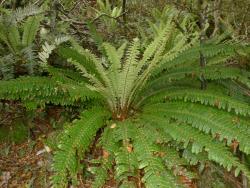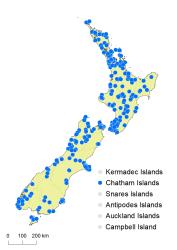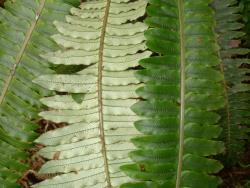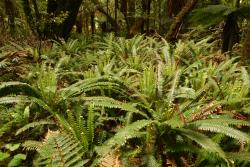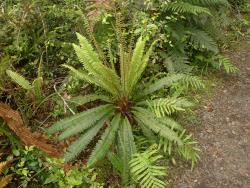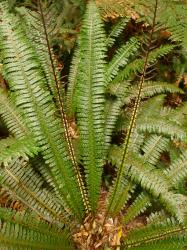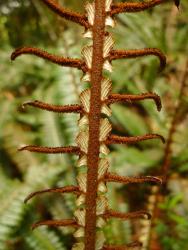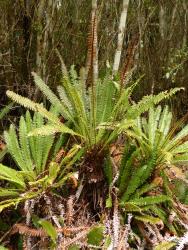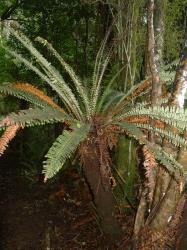- ≡ Osmunda discolor G.Forst., Fl. Ins. Austr. 78 (1786)
- ≡ Gymnopteris discolor (G.Forst.) Bernh., Neues J. Bot. 1(2): 20 (1805)
- ≡ Onoclea discolor (G.Forst.) Sw., Syn. Fil. 111 (1806)
- ≡ Hemionitis discolor (G.Forst.) Schkuhr, 24. Kl. Linn. Pfl.-Syst. 1, 7, t. 6 (1809)
- ≡ Lomaria discolor (G.Forst.) Willd., Sp. Pl. 5(1), 293 (1810)
- ≡ Stegania discolor (G.Forst.) A.Rich., Essai Fl. Nouv.-Zél., 87 (1832)
- ≡ Spicanta discolor (G.Forst.) Kuntze, Revis. Gen. Pl. 2, 821 (1891)
- ≡ Struthiopteris discolor (G.Forst.) Ching, Sunyatsenia 5: 243 (1940)
Rhizomes erect, forming short, woody trunks up to 1250 mm tall (field observation), bearing scales, producing stolons. Rhizome scales linear, 7.5–13 mm long, 0.6–1.2 mm wide, chestnut-brown, concolorous, or bicolorous with paler margins. Fronds strongly dimorphic; sterile fronds (140) 175–1400 mm long, arching upwards or outwards; fertile fronds on same plant usually a little longer, (150) 260–1380 mm long, positioned centrally, held erect. Sterile fronds. Stipes 40–250 mm long, red-brown proximally, yellow-brown distally, bearing linear scales with short, triangular bases, up to 30 mm long. Rachises yellow-brown, grooved adaxially, scaly. Laminae (100) 125–1160 mm long, (33) 44–175 mm wide, pinnatisect, narrowly elliptic, with a very short apical segment, dark green adaxially, paler green abaxially, coriaceous, abundantly covered in red-brown, hair-like scales on both surfaces when young, becoming glabrous with age. Pinnae in (13) 20–62 pairs, closely spaced, narrowly oblong, straight, gradually reducing to the lamina base; the longest pinnae near the middle, (17) 24–90 mm long, 6–16 mm wide, apices acute, margins entire or minutely serrate, bases adnate; the basal pair ± opposite. Veins free. Fertile fronds. Stipes (35) 75–410 mm long. Laminae (115) 160–1070 mm long, (20) 22–105 mm wide. Pinnae in (16) 25–65 pairs, linear, straight, the longest 12–55 mm long, 2–4 mm wide, entirely fertile distally but gradually transitioning to shorter sterile pinnae proximally. Sori and indusia in one row either side of costa, continuous along the length of the distal pinnae, but the proximal segments with a fertile apex and sterile base, or completely sterile.
Note: Figures in brackets are from exceptionally small, fertile plants growing in very exposed conditions.
Blechnum discolor is distinguished by its dimorphic fronds, free veins, pinnatisect sterile laminae, and continuous sori. It has erect rhizomes that sometimes form a short, woody trunk. Plants often develop into extensive colonies by means of stolons that grow from the rhizomes. The sterile laminae are glabrous, narrowly elliptic, dark green on the upper surface but paler below, and divided into 20–62 pairs of narrowly oblong, acute pinnae that reduce gradually in length to each end of the lamina. The fertile fronds are generally longer and narrower than the sterile, and show a marked transition from entirely fertile pinnae at the lamina apex to entirely sterile at the base. The sterile fronds grow out in the form of a crown, with the fertile fronds held stiffly upright in the centre.
Occasional aberrant crested or bipinnate forms are found.
North Island: Northland, Auckland, Volcanic Plateau, Gisborne, Taranaki, Southern North Island.
South Island: Western Nelson, Sounds-Nelson, Marlborough, Westland, Canterbury, Otago, Southland, Fiordland.
Chatham Islands, Stewart Island.
Altitudinal range: 0–1380 m.
Blechnum discolor occurs throughout the North Island from Te Paki to Wellington. It grows from c. 35 m, up to 1380 m in the Tararua Ranges. In the South Island it is widespread in lowland and montane areas, and absent only from the drier parts of Marlborough, south Canterbury and Otago. It extends from near sea level to 1050 m in the Rolleston Range, Canterbury. It also reaches Stewart Island and the Chatham Islands.
Blechnum discolor is a terrestrial fern found in kauri, podocarp, broadleaved and beech forest, under mānuka, kānuka and coastal scrub, sometimes in rough pasture, and occasionally under Salix species. It grows on the forest floor, on old stumps, on slopes, on stream banks and river terraces, on tracksides, on roadside banks, and in dune hollows. It favours more open areas, and often forms extensive colonies by means of its stoloniferous habit.
n = 28 (Brownlie 1954).



